Marble floors are the pinnacle of elegance and sophistication in home décor. Their distinctive veining, patterns, and polished finish, which produce a classic look that emanates luxury, are the source of their inherent elegance.
Marble has an opulent appeal that is tactile and visual, giving any area a decidedly sophisticated and comfortable feel because of its cool, smooth surface.
But it's crucial to preserve marble elegance. Maintaining their immaculate beauty requires frequent washing and upkeep.
Because marble is a porous stone, abrasion, etching, and stains can occur. Its luster may fade, and flaws may build if proper care is taken.
Maintaining your marble floor maintenance properly will shield your investment and keep them as a representation of elegance and sophistication.
You may enjoy the long-lasting beauty and comfort of your marble flooring by applying gentle yet efficient cleaning techniques, stain prevention, and quick spill cleanup.
The attention to detail you put into these beautiful surfaces preserves not just their tactile and visual beauty but also the natural grandeur that marble lends to your home or place of business.
To preserve the timeless elegance and durability of your surfaces, make sure you have marble floor cleaning tools and equipment.. Marble needs extra care and attention because it is a delicate and porous material.
Here's a comprehensive list of the necessary cleaning materials and tools for this purpose:
Gathering Cleaning Supplies for Marble Floors:
Tools:
Soft Sponge: For delicate cleaning, especially stain and spill removal, use a soft sponge.
Squeegee: To avoid streaks and water stains, a squeegee works well for rapidly drying marble after mopping.
Soft, Natural Bristle Brush: This is a useful tool for cleaning corners and grout lines that are difficult to reach.
Buffer or Polishing Machine: You should spend money on a buffer or polishing machine made specifically for marble floors if you plan to do extensive polishing on a regular basis.
Dustpan: A dustpan is used to gather the particles that the broom has swept up.
Gloves: Wear gloves to shield your hands from any filth or cleaning agents.
Having these cleaning materials and equipment on hand will guarantee that you are prepared to clean and care for your marble flooring properly.
Make sure your cleaning solution and instruments are appropriate for your marble surfaces by conducting a spot test in a discrete area.
Always follow the manufacturer's instructions and guidelines for the particular marble goods you are using. Your marble floors will seem beautiful and elegant for many years if they are properly maintained.
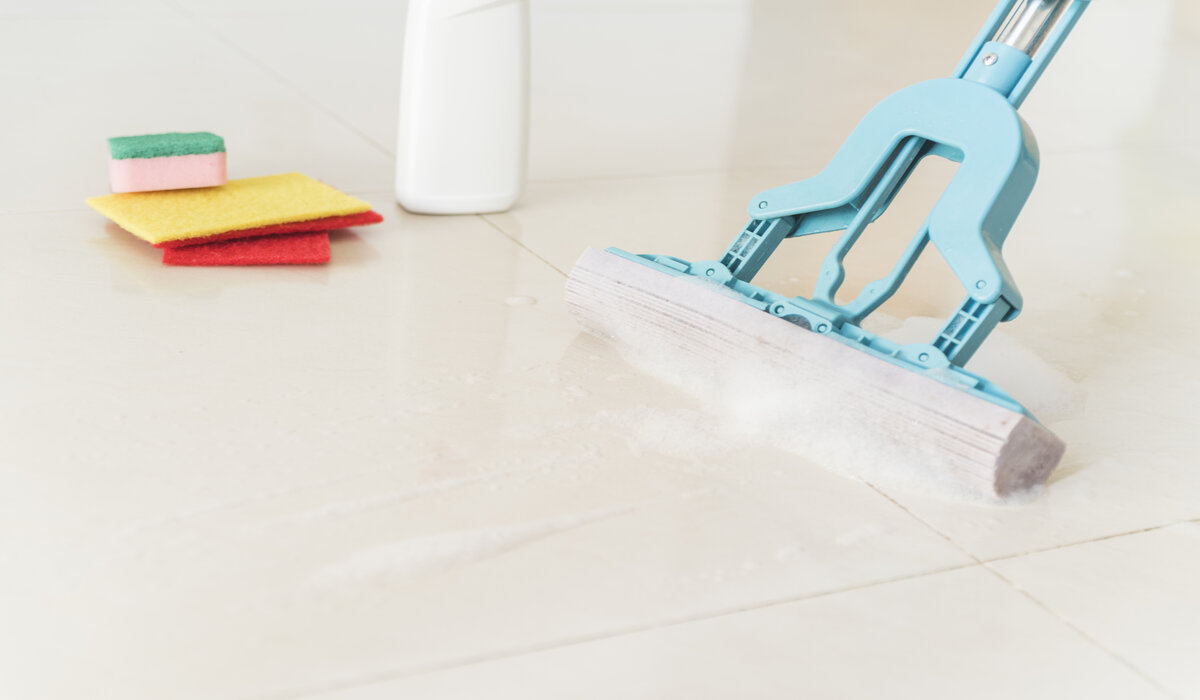
Cleaning marble floors effectively and maintaining the finest possible appearance of flooring demands regular cleaning as well as occasionally removing stains from marble.
This step-by-step marble cleaning manual covers both aspects of properly cleaning marble floors:
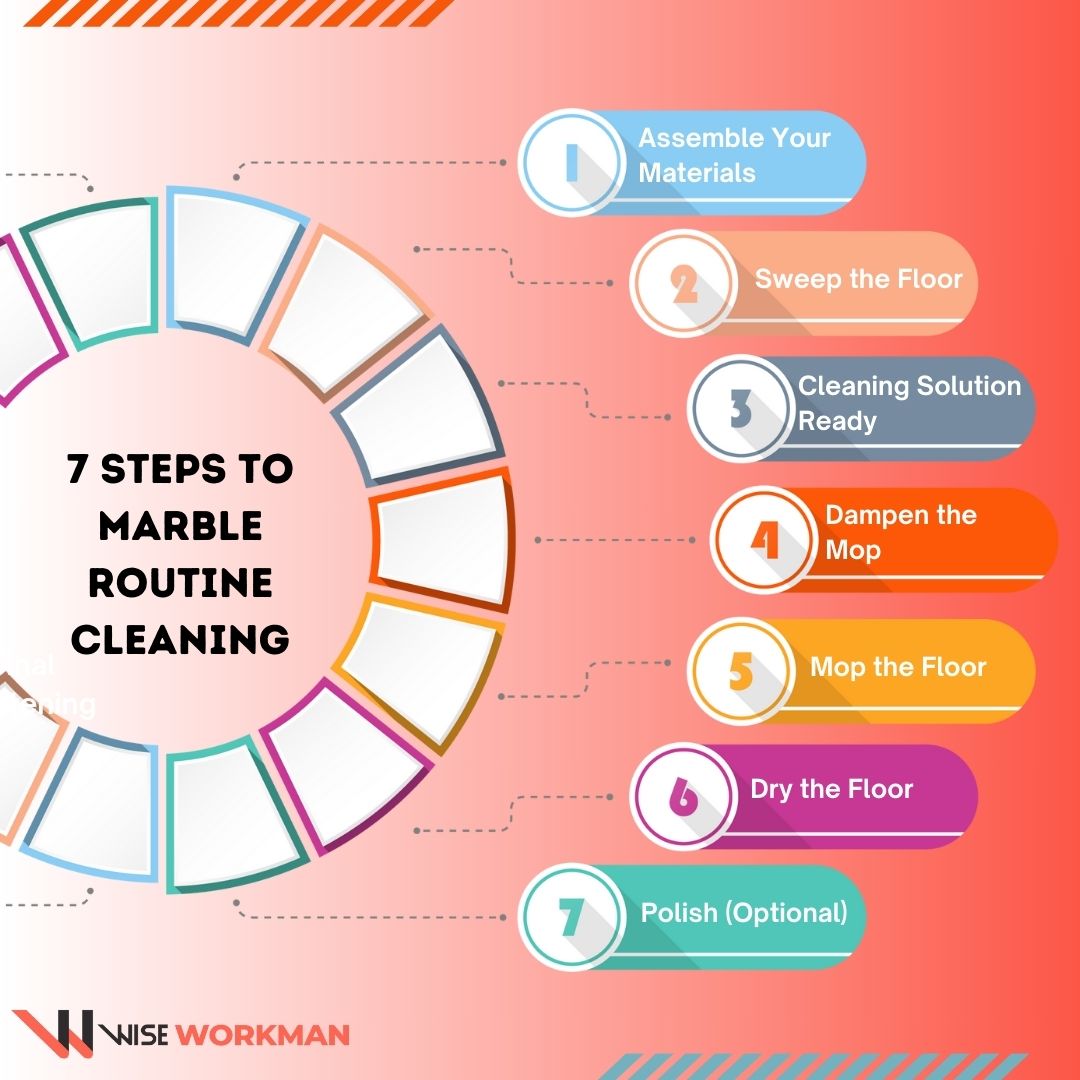
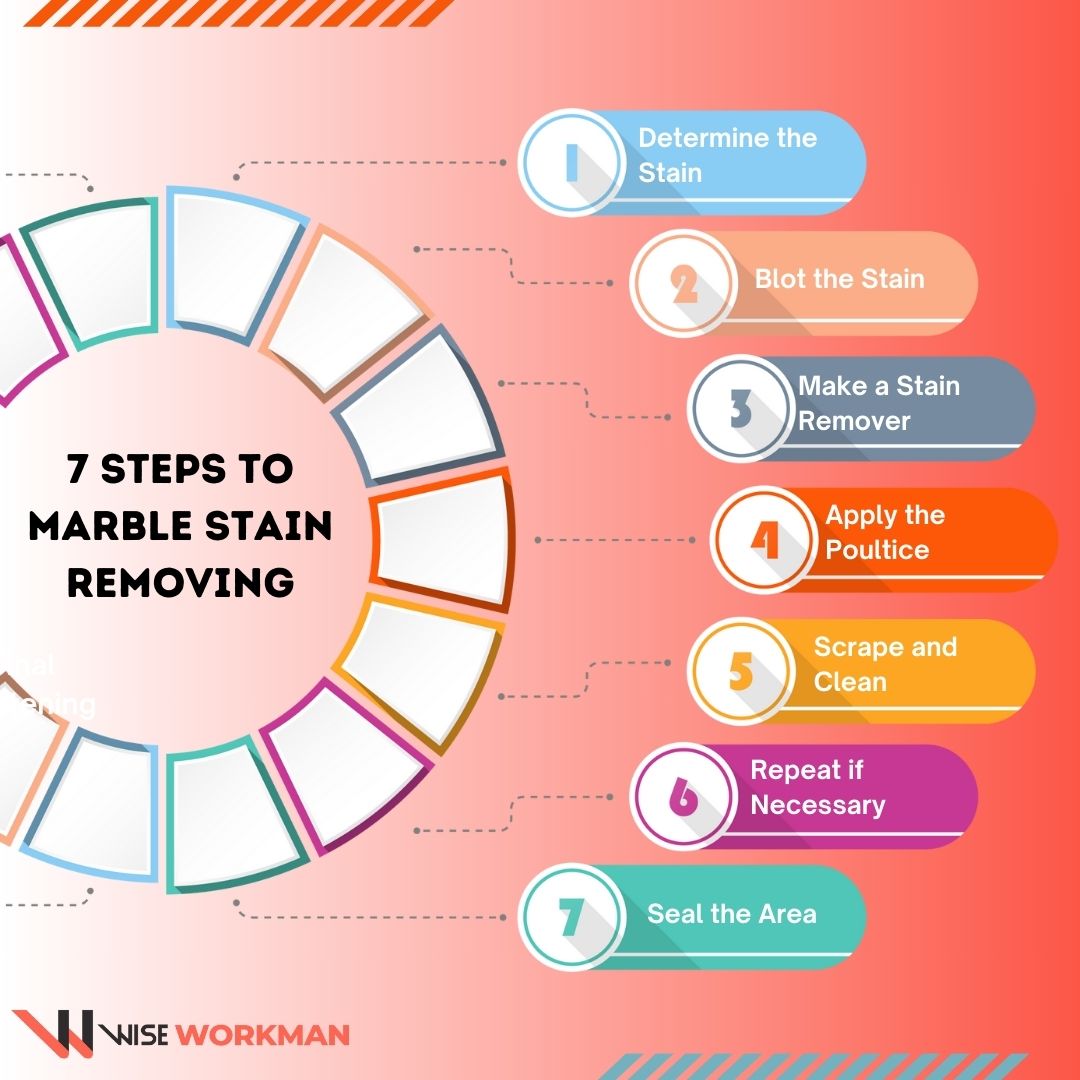
To maintain the elegance of your marble flooring, you must do routine maintenance and stain removal as soon as possible. You may appreciate the beauty and toughness of your marble floors for many years to come if you follow these detailed recommendations.
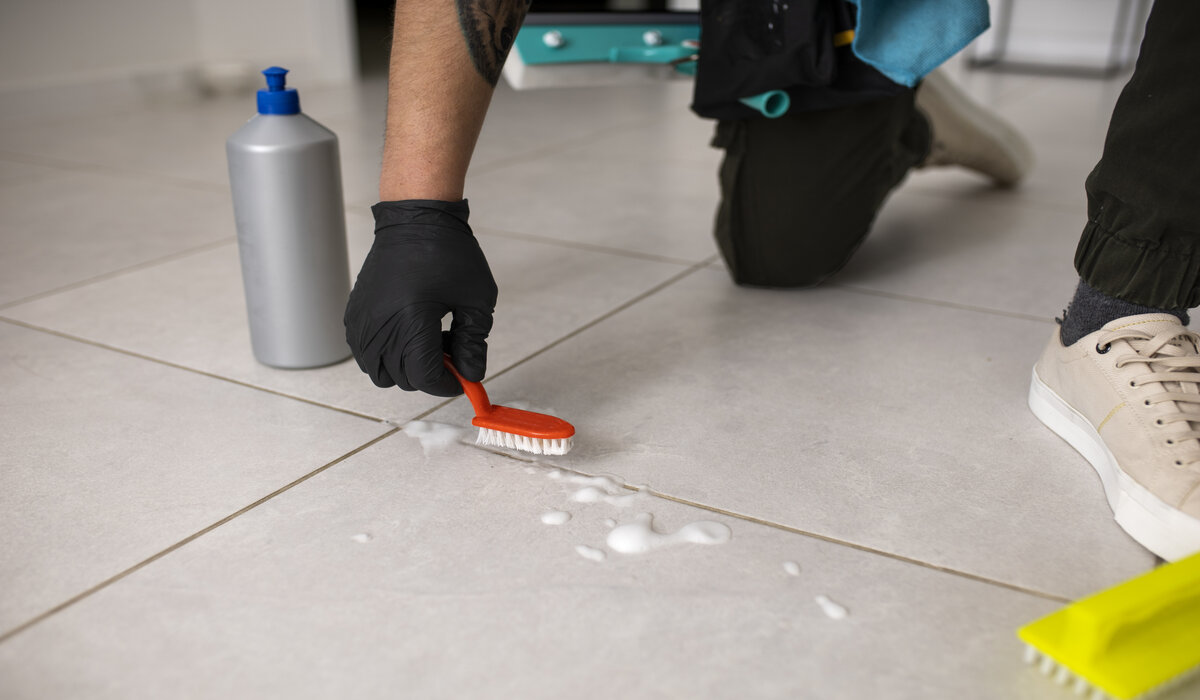
When it comes to protecting marble surfaces and restoring marble shine and safeguarding these exquisite surfaces, polishing and sealing are two essential maintenance procedures. This explains why they are significant:
1. Polishing Marble to Bring Back Its Shine:
Increasing Aesthetic Appeal: Foot activity, ageing, and exposure to different conditions can cause marble flooring to lose their lustre over time. Polishing brings out the lustre and vitality of the marble, restoring and enhancing its natural beauty.
Smoothing Surface flaws: Polishing leaves marble floors looking faultless and smooth by removing little etching, scratches, and surface flaws that can build up.
Increased Light Reflection: The room will appear brighter and more opulent thanks to the polished marble surface's enhanced ability to reflect light.
2. Sealing Marble Surfaces to Protect Them:
How to Prevent Stains: Because marble is porous and readily absorbs liquids, spills of acidic materials like wine can leave stains on the surface. By erecting a barrier of defense against liquids, sealing lowers the possibility of discoloration.
Reducing Etching: Marble can be etched by acidic materials like vinegar or lemon juice, which leave behind dull stains. The integrity of the marble is maintained by sealing, which also protects against these chemical processes.
Minimising Water Damage: Marble is susceptible to moisture damage, such as erosion and efflorescence, which are white, powdery deposits. Sealing provides a barrier against the infiltration of moisture.
Maintaining Lifespan: Sealing marble floors keeps them safe from normal wear and tear, such as abrasion, foot traffic, and cleaning.
Sealing provides protection against potential damage from stains, etching, and moisture, while polishing and sealing for marble floor care.
When combined, these procedures guarantee that your marble flooring will continue to be stunning, strong, and resilient for many years to come.
For marble surfaces to remain elegant and long-lasting in both home and commercial settings, regular maintenance is necessary, including periodic polishing and sealing.
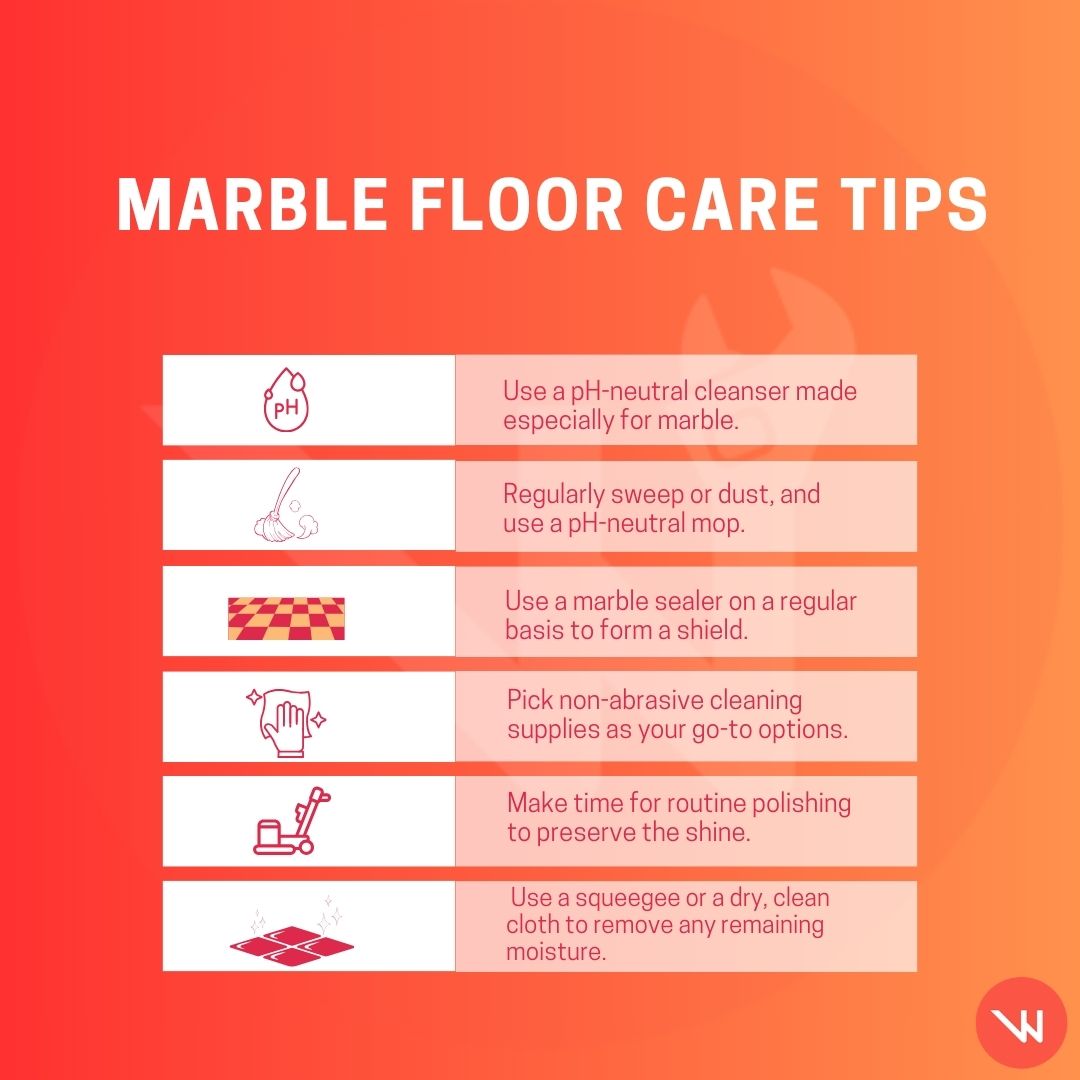
Marble flooring needs special cleaning techniques, and frequent errors can cause degradation and damage.
Here are some common errors people make when cleaning marble floors, along with advice on avoiding marble cleaning mistakes and helpful tips for marble floor care:
1. Employing Incorrect Cleaners:
Mistake: In the mistaken belief that acidic or abrasive cleaners are effective, many individuals use them. But these can etch marble, causing harm to its surface.
Tip: Whenever possible, use a pH-neutral cleanser made especially for marble. It won't damage the stone and will clean well.
2. Neglecting Routine Upkeep:
Mistake: If regular cleaning is neglected, dirt and debris will gather and your marble floors will become less shiny and appealing.
Tip: To avoid accumulation, set up a regular cleaning routine. Regularly sweep or dust, and use a pH-neutral mop.
3. Ignoring Leaks and Discolorations:
Mistake: Letting spills remain on the marble may cause etching or staining that is irreversible.
Tip: Wipe up spills as soon as possible using a paper towel or soft cloth, and stay away from harsh chemicals. For tough stains, apply a poultice.
4. Excessive Water Use:
Mistake: Excessive use of water during cleaning might cause water damage by penetrating the porous marble.
Tip: After cleaning, make sure your mop is completely wrung out and use a squeegee or a dry, clean cloth to remove any remaining moisture.
5. Ignoring the sealing:
Mistake: If you don't seal your marble floors, they can get damaged, stained, and etched.
Tip: Use a marble sealer on a regular basis to form a shield. The type of marble and how it is used determine how often it needs to be sealed.
6. Using Improper or Rough Tools:
Mistake: Marble can be scratched and damaged by using hard-bristle brushes or abrasive scrubbers.
Tip: Pick non-abrasive cleaning supplies and soft, natural bristle brushes as your go-to options. The best tools are soft cloths and microfiber mops.
7. Failure to Test New Products:
Mistake: Applying a new cleaning product without first evaluating it in a discrete area may cause unanticipated harm.
Tip: Before using a new cleaner or stain remover on a visible portion of your marble floor, always do a spot test on a small part of the floor.
8. Ignoring Frequent Polishing:
Mistake: The marble may eventually lose its original luster if it is not regularly polished.
Tip: Make time for routine polishing to preserve and bring back the shine of your marble floors.
Your marble floors will stay stunning, strong, and damage-free if you prevent mistakes in marble floor cleaning. Your marble surfaces will remain elegant and long-lasting with proper maintenance.
To guarantee marble floor longevity and continue to be a magnificent center point in your house or place of business, regular maintenance is necessary. The following are crucial routine upkeep procedures for sustaining the beauty of marble:
1. Consistent Cleaning:
2. Stain Prevention:
3. Frequent Sealing:
4. Polish Periodically:
5. Area Rugs and Mats:
6. Soft Brush Attachments:
7. Refrain from Harsh Chemicals:
8. Furniture Pads:
9. Professional Maintenance:
10. Routine Inspection:
You can make sure that your marble floors maintain their sophisticated appearance, durability, and timeless beauty by putting these routine maintenance procedures into place.
Keeping your marble floors elegant with the right maintenance will keep improving the look of your room for many years to come.
Therefore knowing how to clean marble floors and to maintain the enduring elegance of marble floors and beauty of this magnificent natural stone, proper maintenance is vital. Marble flooring is a popular option for both homes and businesses because of their timeless elegance.
You can experience the fulfilment of embracing the timeless beauty of marble floors by making the appropriate care practises investments.
Marble's distinctive veining, organic patterns, and brilliant lustre are what make it so appealing; but, if sufficient care is not given, these features may deteriorate over time.
Your marble floors need to be cleaned, sealed, and polished on a regular basis to maintain their finest appearance. In addition to improving the stone's appearance, this care keeps it safe from wear, etching, and stains.
Appreciating well-maintained marble lies in realising its classic elegance. Perfect marble floors add a sense of refinement and sophistication to any area, whether it be a formal living area, a large foyer, or a smart corporate environment.
They turn into an enduring representation of your dedication to superior design and upkeep. Marble floors are a treasured investment that only increases in value with time because of their timeless elegance, which exudes pride, richness, and refinement.